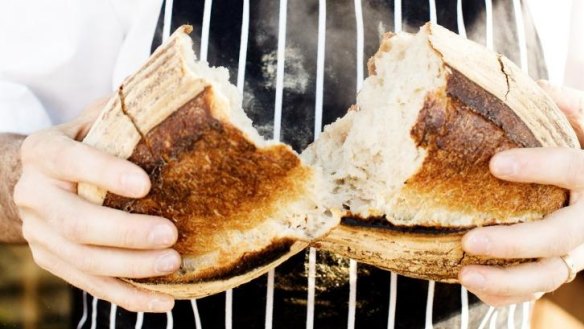Does sourdough use yeast?

Does sourdough use yeast? M. Pola
One knows one has time on one's hands when one rings the help line of a multinational-owned baker to complain that the sourdough loaf one is holding was soured with vinegar, not sourdough culture. It is even more embarrassing when the said multinational apologises and sends a $5 gift voucher to replace the loaf, which was actually left by a relative staying for the weekend. Sourdough "mother" or "starter" is initially made from a flour and water paste that is left for several days to recruit microscopic bugs naturally occurring in the air. Some are lactobacilli that turn lactose into lactic acid. Others are acetobacter that transform the alcohol made by yeasts into acetic acid. Then there are the yeasts that break down starch into sugars and sugars into CO2 and alcohol. So yes, your sourdough loaf does contain yeast and a whole lot more other bugs.
Can I cook with emu eggs? V. Caruthers
In Victoria Heywood's book Possum Pie, Beetroot Beer and Lamingtons, there is a recipe for emu-egg sponge. It appears above a recipe for stuffed, baked possum. It reads to take one emu egg, crack it into a bowl then whisk it for five minutes; then whisk in a cup and a half of sugar for 15 minutes until light and foamy. Then sift two teaspoons of baking powder into two cups of plain flour and fold this into the foamed eggs. Then add one cup of boiling water in which a tablespoon of butter has been melted. Pour the mix into two well-greased large sandwich tins and "bake in a quick oven". Melbourne chef Shannon Bennett has made emu-egg sponges at the Piggery Cafe at Burnham Beeches in the Dandenong Ranges. His recipe makes three 20cm sponge cakes and he says that one 500g emu egg is equivalent to 14 large hen's eggs. That would make scrambled eggs for about six. If planning to cook with emu eggs please procure them from a specialist vendor and do not steal from nests in the wilds. Emus can run faster than 60 km/h and have talon-like claws – think velociraptor with a quizzical expression.
Why are lettuces called lettuce? M. Laszlo
In Spanish it's lechuga, in French laitue and in both examples you can sense the word for milk. Leche in Spanish and lait in French. The word lettuce comes to us from Middle English letus from the plural of Anglo French's letue. They all stem from the Latin lactuca or milk. This refers to the milky sap, or lactucarium, that exudes from the cut stems of lettuce. This substance has been described as a mild analgesic in traditional medicine and is still used as such in some countries.
What is mutton mould? C. Steel
This is a classic Edwardian era leftovers dish of 500g of leftover baked mutton or lamb that is minced with ½ small onion, ⅓ cup breadcrumbs, herbs, salt and pepper, a tablespoon of chutney and the same of leftover gravy. This is mixed together with an egg and placed in a pudding bowl, pressed, covered with baking paper, tied off and steamed in simmering water for one hour. It was traditionally served with macaroni and gravy.
Letters
The mere mention of pressure cooker had readers all steamed up with several chastising me for failing to warn other readers of the dangers of exploding pressure cookers. Others berated me for failing to mention that they are available from most Indian grocers, with J. Togno stating that he is "reliably informed that pressure cookers are the secret weapon of many an Indian wife for putting a tender curry on her table." Then A. Finch broke our hearts with this tender recollection. "My husband Lloyd, who can't boil an egg, courted me with a meal cooked in a pressure cooker in 1948 while his mother was in away in the UK. I had one on my bridal wish-list when we were married in 1950, although I was scared of them after the contents of my mother's pressure cooker hit the kitchen ceiling after father opened hers with brute force."
Send your vexing culinary conundrums to brainfood@richardcornish.com.au or tweet @FoodCornish
The best recipes from Australia's leading chefs straight to your inbox.
Sign up